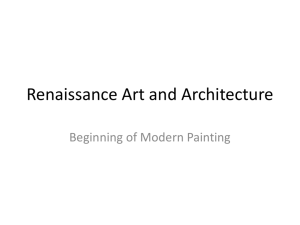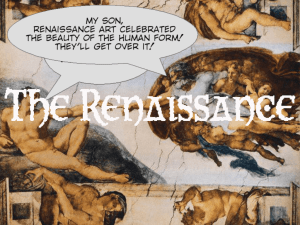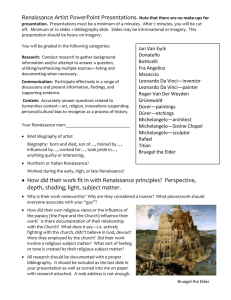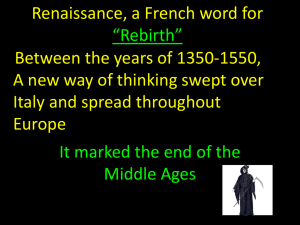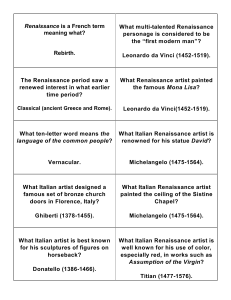People of the Renaissance and Practice Worksheets
advertisement
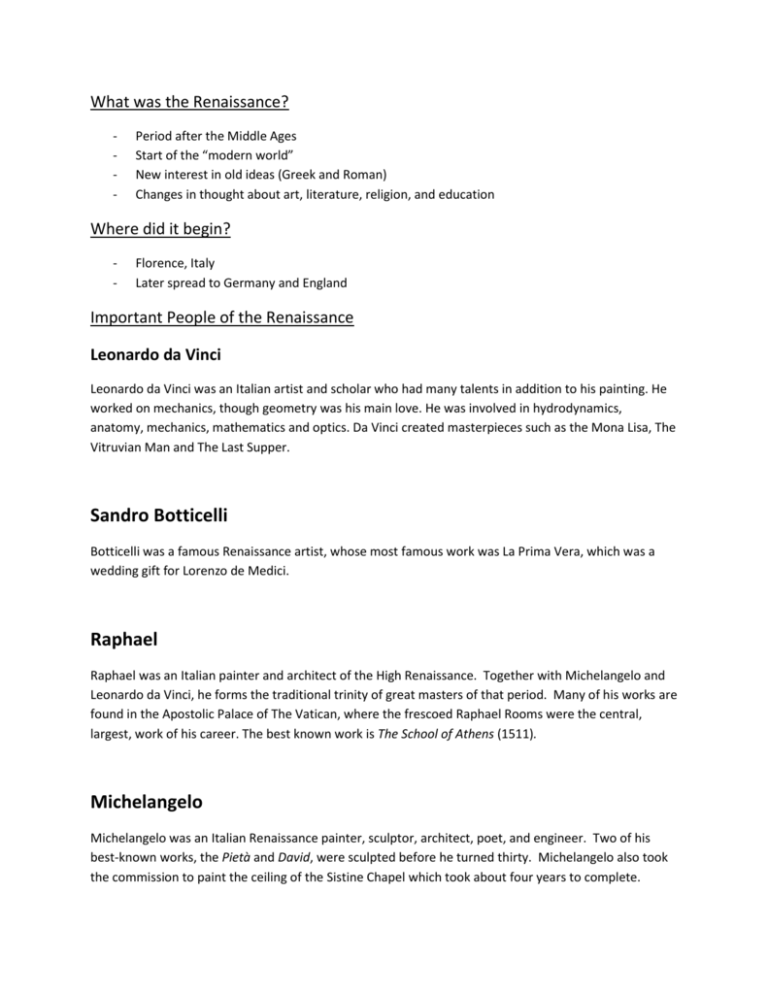
What was the Renaissance? - Period after the Middle Ages Start of the “modern world” New interest in old ideas (Greek and Roman) Changes in thought about art, literature, religion, and education Where did it begin? - Florence, Italy Later spread to Germany and England Important People of the Renaissance Leonardo da Vinci Leonardo da Vinci was an Italian artist and scholar who had many talents in addition to his painting. He worked on mechanics, though geometry was his main love. He was involved in hydrodynamics, anatomy, mechanics, mathematics and optics. Da Vinci created masterpieces such as the Mona Lisa, The Vitruvian Man and The Last Supper. Sandro Botticelli Botticelli was a famous Renaissance artist, whose most famous work was La Prima Vera, which was a wedding gift for Lorenzo de Medici. Raphael Raphael was an Italian painter and architect of the High Renaissance. Together with Michelangelo and Leonardo da Vinci, he forms the traditional trinity of great masters of that period. Many of his works are found in the Apostolic Palace of The Vatican, where the frescoed Raphael Rooms were the central, largest, work of his career. The best known work is The School of Athens (1511). Michelangelo Michelangelo was an Italian Renaissance painter, sculptor, architect, poet, and engineer. Two of his best-known works, the Pietà and David, were sculpted before he turned thirty. Michelangelo also took the commission to paint the ceiling of the Sistine Chapel which took about four years to complete. Donatello Donato di Niccolò di Betto Bardi, also known as Donatello, was an early Renaissance Italian artist and sculptor from Florence. Important works of his include; the bronze David, St. George, and the Equestrian Monument of Gattamelata. Dante Alighieri Alighieri was a major Italian poet, whose “Divine Comedy” is considered the greatest literary work composed in the Italian language. William Shakespeare William Shakespeare became the most popular dramatist, but he looked mainly to poetry not playwriting. He wrote The Sonnets of Shakespeare , which consisted of 154 sonnets. He also wrote 30 plays mainly in the four categories: histories, comedies, tragedies, and romances. Shakespeare wrote Romeo and Juliet in 1596 and many other plays such as: Julius Caesar, Hamlet, Othello, King Lear, Macbeth, and Anthony and Cleopatra. Match the work with the artist/writer (some individuals may be used twice): Michaelangelo La Prima Vera Botticelli Othello Da Vinci School of Athens Shakespeare David Alighieri The Vitruvian Man Raphael The Inferno Donatello Hamlet The Mona Lisa the Pieta St. George Answers Michelangelo – David, the Pieta Da Vinci- The Vitruvian Man, the Mona Lisa Botticelli – La Prima Vera Alighieri – The Inferno Shakespeare – Hamlet, Othello Raphael – School of Athens Donatello – St. George Compare and Contrast Renaissance and Medieval Characteristics Answers Medieval 2 – Dimensional Flat Story-telling (Religion or Warfare) Renaissance Resurgence of classical values Linear perspective use of light & shadow All faces the same, not realistic three dimensional, realistic Hieratic Scales – most important use of human anatomy aspect of painting is the biggest depict beauty of nature size of objects accurate Multiple choice questions 1. What was a characteristic of Renaissance Art? a. 2- dimensional c. use optical color blending to trick the eye b. use of light and shading d. Focus on fundamental materials in artwork 2. Who was NOT a Renaissance artist? a. Giovanni Bellini c. Filippo Brunelleschi b. Da Vinci d. Donatello 3. Who was the artist behind the painting of the Sistine Chapel? a. Da Vinci c. Botticelli b. Raphael d. Michelangelo 4. What artist was the court painter for the de Medici family? a. Sandro Botticelli c. Michelangelo b. Leonardo da Vinci d. Lorenzo Monaco 5. Who was the artist behind The Vitruvian Man? a. Peter Paul Rubens c. Michelangelo b. Da Vinci d. Giovanni Bellini Answers 1. b 2. c 3. d 4. a 5. b
